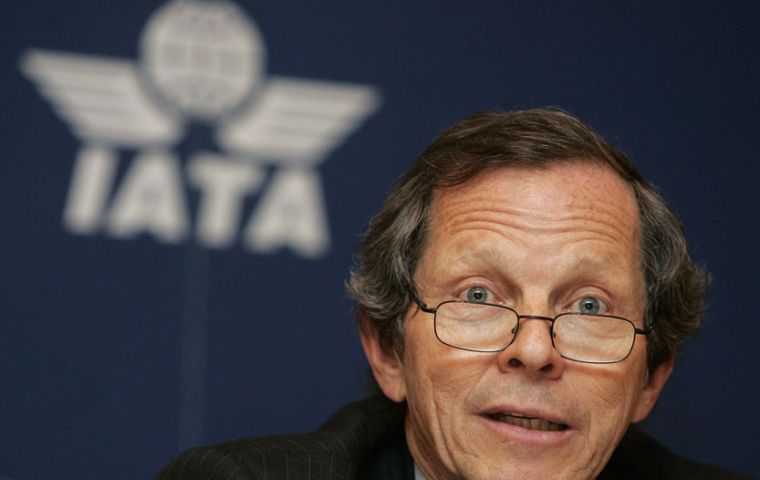MercoPress. South Atlantic News Agency
“Faster than anticipated recovery” for air passenger and cargo traffic says IATA
 Giovanni Bisignani, IATA’s Director General and CEO praised the consolidation of Chile’s LAN with Brazil’s TAM.
Giovanni Bisignani, IATA’s Director General and CEO praised the consolidation of Chile’s LAN with Brazil’s TAM. Demand for international passenger and cargo traffic increased 9.2% and 22.7% respectively in July compared to the same month a year ago, according to the International Air Transport Association (IATA). The year-on-year comparisons for July were less than the June growth data showing 11.6% and 26.6% increases respectively.
According to IATA the apparent slowdown was entirely due to the fact that by July 2009 traffic was already starting to recover. After adjusting for seasonality, the improvement in demand was faster month-to-month in July than it was in June.
IATA states it is clear that the recovery has entered a slower phase. During the second half of 2009, demand was rebounding at an annualized rate of 12% for passenger and 28% for cargo. In the year to July, the annualized growth rates had dropped to 8% for passenger and 17% for air freight. However, this is still considerably above the industry’s traditional 6% growth trend.
“The recovery in demand has been faster than anticipated. But, as we look towards the end of the year, the pace of the recovery will likely slow. The jobless economic recovery is keeping consumer confidence fragile, particularly in North America and Europe. This is affecting leisure markets and cargo traffic. Following the boost of cargo demand from inventory re-stocking, further growth will be largely determined by consumer spending which remains weak,” said Giovanni Bisignani, IATA’s Director General and CEO.
July global passenger traffic was 3% higher than the pre-crisis levels of early 2008: Asia-Pacific carriers outperformed the industry average with a 10.9% growth in July. This is consistent with the region’s 10.6% growth measured year-to-date.
The European airlines beleaguered by the region’s weak economy, saw little growth when the recovery took off in the second half of 2009. In July, passenger demand was up by 6.2% over the same month in 2009. But the region’s slow start in the recovery process has seen it deliver the weakest demand performance among all the regions over the first seven months of the year (+3.6%).
North American carriers recorded a 7.9% improvement in passenger demand in July over the same month in the previous year. Over the first seven months of the year, the region’s carriers recorded a 6.3% increase, but kept capacity expansion to just 1.0%, raising load factors to 82.0% and producing strong gains in unit revenues that will support the region’s return to profitability this year.
African airlines are now benefiting significantly from the economic and travel upturn, outperforming the industry with 13.0% growth in passenger demand in July, which is consistent with the year-to-date improvement of 13.1%.
Latin American carriers outperformed the global average with passenger growth of 14.2% in July (10.9% for the first seven months of the year). Faster capacity additions have seen load factors drop, which will limit gains in financial performance.
Middle Eastern carriers continue to add the largest amount of capacity (12.8% in July and 13.2% over the first seven months of the year). The region’s carriers have managed to increase demand at even higher levels (16.8% in July and 19.4% over the first seven months of the year).
Regarding cargo July demand was 4% higher than pre-crisis levels in early 2008. However a slowdown in air freight markets is expected in the second half of the year as the economic cycle moves into a new phase. Extraordinary freight growth rates in late 2009 and early 2010 were supported by businesses re-stocking their inventories. With the re-stocking cycle completed, air freight demand will be driven by consumer spending and business capital expenditure.
The two-speed recovery continues to see weak growth by European carriers of 12.1% in July, less than half the 25.3% increase by Asia-Pacific carriers or the 27.1% growth recorded by North American carriers.
“Improving demand is an important component of the recovery. But it must translate to the bottom line. The anticipated 2010 profit of 2.5 billion US dollars is only a 0.5% return on revenues. Hence, the financial situation of the industry remains fragile. We must go beyond recovery to secure sustainable profitability at levels exceeding the 7-8% cost of capital. For this, we need a change in the industry’s structure,” said Bisignani.
Bisignani also noted the need for a regulatory structure that facilitates consolidation across political borders. “The crisis has seen consolidation in Europe and the US. The merger announcement by LAN and TAM brings Latin America into the picture. And trans-national brands are serving customers effectively in many parts of the world. But we remain an industry of over a thousand players with only very limited opportunities to consolidate as a result of the antiquated bilateral system’s restrictions on ownership. The business realities of the industry are changing. It is critical that governments find a modern regulatory structure that is free of outdated ownership restrictions and able to facilitate opportunities for consolidation globally—something that other industries take for granted” concluded Bisignani.




Top Comments
Disclaimer & comment rulesCommenting for this story is now closed.
If you have a Facebook account, become a fan and comment on our Facebook Page!